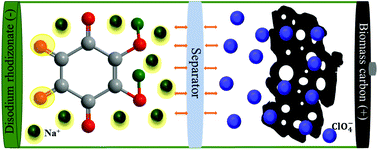当前位置:
X-MOL 学术
›
Green Chem.
›
论文详情
Our official English website, www.x-mol.net, welcomes your
feedback! (Note: you will need to create a separate account there.)
High performance organic sodium-ion hybrid capacitors based on nano-structured disodium rhodizonate rivaling inorganic hybrid capacitors
Green Chemistry ( IF 9.3 ) Pub Date : 2018-09-19 , DOI: 10.1039/c8gc01987h Ranjith Thangavel 1, 2, 3, 4 , Rubha Ponraj 4, 5, 6, 7 , Aravindaraj G. Kannan 4, 5, 6, 7 , Karthikeyan Kaliyappan 5, 8, 9, 10 , Dong Won Kim 4, 5, 6, 7 , Zhongwei Chen 5, 8, 9, 10 , Yun-Sung Lee 1, 2, 3, 4
Green Chemistry ( IF 9.3 ) Pub Date : 2018-09-19 , DOI: 10.1039/c8gc01987h Ranjith Thangavel 1, 2, 3, 4 , Rubha Ponraj 4, 5, 6, 7 , Aravindaraj G. Kannan 4, 5, 6, 7 , Karthikeyan Kaliyappan 5, 8, 9, 10 , Dong Won Kim 4, 5, 6, 7 , Zhongwei Chen 5, 8, 9, 10 , Yun-Sung Lee 1, 2, 3, 4
Affiliation

|
Sodium hybrid capacitors (NHCs) have tremendous potential to meet the simultaneous high energy–high power requirement of next-generation storage applications. But NHCs still face some obstacles due to poor sodium ion kinetics, low power, and poor cyclability while working with several inorganic sodium ion hosts. Additionally, developing high-performance NHCs that are sustainable and versatile is more crucial from the perspective of energy storage devices. Here, we report a conceptually new and high performance organic sodium hybrid capacitor (ONHC) system, developed by substituting a conventional toxic-metal-containing inorganic battery electrode of an NHC with a nano-structured, metal free, and renewable organic molecule – disodium rhodizonate – to host sodium ions. The sustainability of the ONHC is greatly enhanced by the simultaneous utilization of high surface area cardamom shell (as biomass)-derived porous carbon as a high-power capacitor electrode. The new system exhibits an outstanding performance, delivering a high energy density of ∼87 W h kg−1 along with a high specific power of 10 kW kg−1 (based on the mass in both electrodes), outperforming inorganic sodium hosts. High durability over 10 000 cycles (∼85% retention) with an ultra-low energy loss of ∼0.15% per 100 cycles is also demonstrated, indicating its emergence as a rival to conventional metal containing lithium and sodium hybrid capacitors. The current study provides new opportunities for developing greener and sustainable devices beyond conventional systems for next-generation storage applications.
中文翻译:

基于纳米结构的重氮二钠二钠与无机杂化电容器竞争的高性能有机钠离子杂化电容器
钠混合电容器(NHC)具有巨大潜力,可以满足下一代存储应用同时满足的高能量,高功率要求。但是,由于与几种无机钠离子主体配合使用时,由于不良的钠离子动力学,低功率和不良的可循环性,NHC仍然面临一些障碍。此外,从储能设备的角度来看,开发可持续的,多功能的高性能NHC显得尤为关键。在这里,我们报告了一种概念上新颖的高性能有机钠混合电容器(ONHC)系统,该系统是通过将NHC的常规含毒金属无机电池电极替换为纳米结构,无金属且可再生的有机分子–二钠而开发的Rhodizonate –容纳钠离子。同时使用高表面积豆蔻壳(作为生物质)衍生的多孔碳作为高功率电容器电极,大大提高了ONHC的可持续性。新系统具有出色的性能,可提供约87 W h kg的高能量密度-1以及10 kW kg -1的高比功率(基于两个电极的质量),胜过无机钠基质。还显示了超过10000次循环的高耐久性(约85%的保持力),每100个循环约0.15%的超低能量损耗,表明它已成为与传统的含金属锂和钠混合电容器竞争的对手。当前的研究为开发下一代存储应用的传统系统以外的绿色和可持续设备提供了新的机会。
更新日期:2018-10-30
中文翻译:

基于纳米结构的重氮二钠二钠与无机杂化电容器竞争的高性能有机钠离子杂化电容器
钠混合电容器(NHC)具有巨大潜力,可以满足下一代存储应用同时满足的高能量,高功率要求。但是,由于与几种无机钠离子主体配合使用时,由于不良的钠离子动力学,低功率和不良的可循环性,NHC仍然面临一些障碍。此外,从储能设备的角度来看,开发可持续的,多功能的高性能NHC显得尤为关键。在这里,我们报告了一种概念上新颖的高性能有机钠混合电容器(ONHC)系统,该系统是通过将NHC的常规含毒金属无机电池电极替换为纳米结构,无金属且可再生的有机分子–二钠而开发的Rhodizonate –容纳钠离子。同时使用高表面积豆蔻壳(作为生物质)衍生的多孔碳作为高功率电容器电极,大大提高了ONHC的可持续性。新系统具有出色的性能,可提供约87 W h kg的高能量密度-1以及10 kW kg -1的高比功率(基于两个电极的质量),胜过无机钠基质。还显示了超过10000次循环的高耐久性(约85%的保持力),每100个循环约0.15%的超低能量损耗,表明它已成为与传统的含金属锂和钠混合电容器竞争的对手。当前的研究为开发下一代存储应用的传统系统以外的绿色和可持续设备提供了新的机会。










































 京公网安备 11010802027423号
京公网安备 11010802027423号